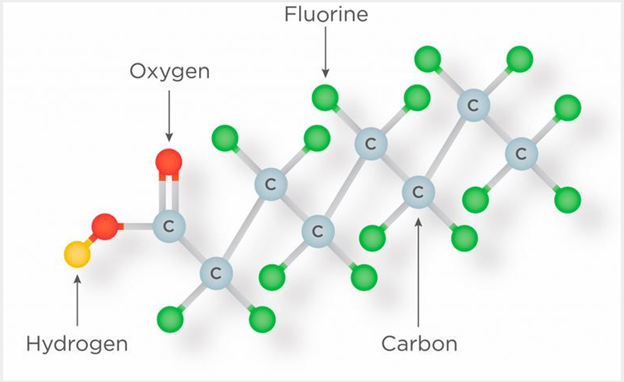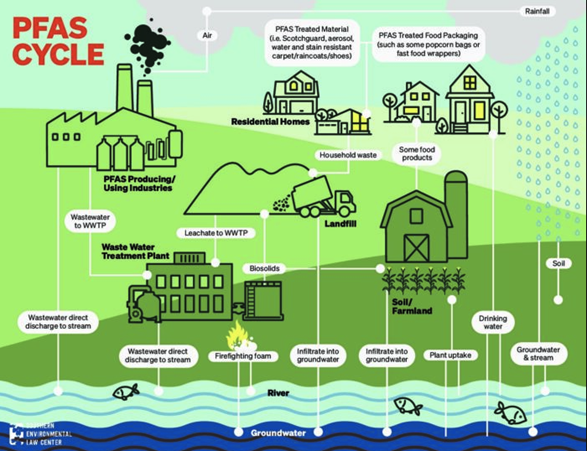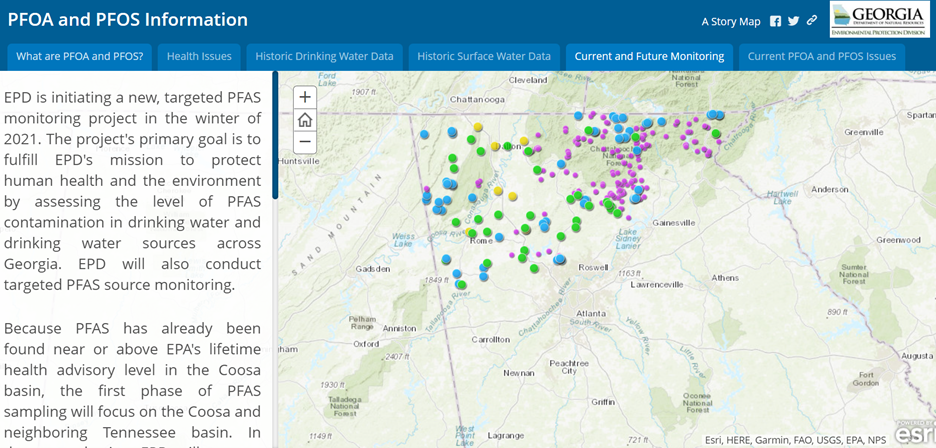“Forever Chemicals” have been in the news a lot lately. Below is some information on what they are and why their presence is a health concern.
Composition of PFAS
Per- per-and polyfluoroalkyl substances (PFAS) are class of chemicals used since the 1950’s to make products resistant to heat, oil, stains, grease, and water. PFAS are widely used as coatings are on a variety of products, including furniture, food packaging, and electrical wire insulation.
PFAS are created by joining carbon and fluorine. This chemical bond is very strong, giving PFAS its desirable properties, but also makes them slow to break down.

PFAS and Human Health
Humans are exposed to PFAS through the food they eat, the water they drink, and the products they use. This exposure impacts human health.
PFAS are everywhere and are a concern to human and environmental health for several reasons.
- PFAS are “forever chemicals.” They remain in the environment and do not break down.
- PFAS are circulated through soils and water which can contaminate drinking water sources.
- This circulation causes PFAS to build up, or bioaccumulate, in fish and wildlife, which may later be consumed.
Research involving human subjects suggest that high levels of PFAS may lead to increased cholesterol levels, decreased vaccine response in children, changes in liver enzymes, increased risk of high blood pressure or pre-eclampsia in pregnant women, decreases in infant birth weights, and increased risk of kidney or testicular cancer. Additional research is needed to understand the dose-response relationship of ever-growing PFAS in the environment and human health.
The National Health and Nutrition Examination Survey (NHANES) measures blood PFAS in a representative sample of the U.S. population every two years, and has historically found that most people have been exposed to PFAS and have PFAS in their blood.

Risk for Georgians
Georgians are especially at risk for PFAS exposure. Scientists have tested more than 100 water treatment plants in north Georgia and found PFAS, among other chemicals linked to cancer and other serious illnesses. Twenty of these sites had PFAS levels about the EPA’s existing threshold. This is likely because of a manufacturing plant located in Dalton, GA that has produced 90% of the world’s carpet and uses PFAS to make fibers more stain resistant. Chemical waste from this plant is treated at the facility, and deposited into the Conasuaga River (an hour and a half north of Atlanta). As one of the most biodiverse river systems in North America, experts are concerned of the impact of PFAS on the ecosystem as well as those who rely on it for drinking water.
This is not the only city in Georgia with high PFAS levels. In 2020, a sampling of drinking water sources in Summerville, GA, found PFAS in levels higher than the EPA health advisory threshold. The Georgia Environmental Protection Division (EPD) maintains a map of current and future PFAS monitoring here. Summerville, Rome, and other affected Georgia cities have spent as much as half a million dollars more a year to install additional drinking water treatment to reduce the unhealthy levels of PFAS. Multiple lawsuits against the companies responsible for the pollution have resulted.

Future Regulation
Historically, PFAS have not been regulated by the EPA. However, in October of 2021, the EPA Administrator Michael Regan announced a PFAS strategic roadmap, which sets a four year timeline by which EPA plans to take specific actions.
This roadmap outlines actions across three central directives:
- Research: Invest in research, development, and innovation to increase understanding of PFAS exposures and toxicities, human health and ecological effects, and effective interventions that incorporate the best available science.
- Restrict: Pursue a comprehensive approach to proactively prevent PFAS from entering air, land, and water at levels that can adversely impact human health and the environment.
- Remediate: Broaden and accelerate the cleanup of PFAS contamination to protect human health and ecological systems.
This is an important first step in regulation of forever chemicals. Multiple pieces of legislation have been introduced at the Federal Level to follow-on to the EPA’s roadmap. Environmental and health advocacy groups are closely watching this roadmap legislation; however, many would like to see more action being taken.
Take Action
The current scientific evidence supports prevention, regulation, and cleanup of PFAS chemicals. Write your legislator to share your input and thoughts on how we should address PFAS.
